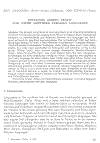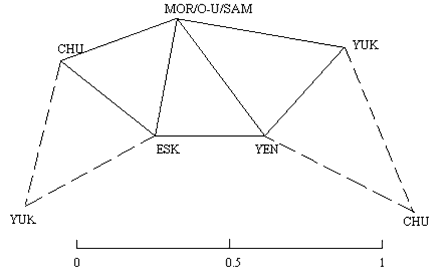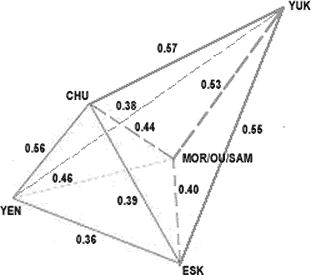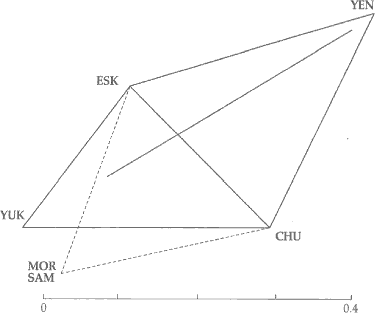161
1. Introduction
Languages in the northern belt of Eurasia are traditionally grouped
as Indo-European, Uralic, Altaic and a loose residual collection of Paleo-Siberian
languages that extend to Eskimo-Aleut in circumpolar North America and Greenland. Angela
Marcantonio (2002) has recently questioned the validity of the Uralic grouping that joins
Samoyedic and Finno-Ugric, arguing that Samoyedic and even Ob-Ugric may have as much in
common with Northern Tungusic as with the rest of the Finno-Ugric languages. She also
argues that Hungarian may be as close to Turkic as to the conventional Uralic grouping.
Instead of clearly distinct groups, there may be a continuum of languages in contact,
ranging from Finnic, Saamic, Mordvin, Mari, Permic, Hungarian, Ob-Ugric and Samoyedic to
Altaic and Paleo-Siberian languages.
These challenging ideas resonated with a group of linguists, motivating them to gather a
collection of 60 structural features and determine their essentially present occurrence
or non-occurrence in languages ranging from Indo-European all the way to Eskimo-Aleut.
Their results (Klesment, Kunnap, Soosaar, Taagepera 2003) confirmed the existence of a
distinct Uralic bloc but also gave some credence to the notion of a continuum. The
emphasis of P. Klesment, A. Kunnap, S.-E. Soosaar, R. Taagepera (2003) was on
establishing and documenting a database for occurrence of structural features, while the
resulting analysis remained cursory. The present study builds on this database but
excludes the Indo-European languages and 14 of the 60 features, for reasons explained in
Appendix, which lists the remaining 46 features.
Two related restrictions characterize the database established by P. Klesment, A. Kunnap,
S.-E. Soosaar, R. Taagepera (2003). It tries to avoid any preconceived notions about the
origin of languages and, therefore, deals only with commonalities presently observed.
(1)
This endeavor makes it bypass lexical similarities, which inevitably lead to
reconstruction toward hypothetical proto-languages in what risks becoming circular
reasoning (cf. Ostman, Raukko 1995). Some lexical similarities may result from sheer
chance (see Ringe 1999; Marcantonio 2002: 136-153). Along with Klesment, Kunnap, Soosaar,
Taagepera 2003, we avoid placing trust in the existing etymological sets.
(2)
The questionable nature of the existing etymological set of Uralic vocabulary is
reinforced by more universal concerns. Historical linguistic statistics specialist Sheila
Embleton observes with good reason that "Linguistically, words are perhaps easier to work
with: 'universals' are most easily avoided; words tend to be longer than affixes or other
functional elements (short forms are more prone to chance resemblances ...). [ - -] It is
often assumed that morphosyntactic data should be considered primary when assessing
genetic relationship, largely because it is assumed to be immune from borrowing."
(Embleton 1986 : 165 - 166; but cf. e.g., McMahon, McMahon 2003). If some researchers feel
comfortable with using lexical features, let them do so, but it should not be a demand
imposed on others.
We do not exclude the possibility that morphosyntactic features might also be borrowed by
one language from another. Alexandra Aikhenvald, in particular, has lately pointed out
the extensive travel of morphosyntactic features among the Amazonian languages in South
America (Aikhenvald 2003 : 1-2): "In the linguistic area of the Vaupes in northwest
Amazonia, several different mechanisms help create new contact-induced morphology. [ - -]
Language contact in the multilingual Vaupes linguistic area has resulted in the
development of similar - though far from identical -grammatical structures. [ - -]
Languages in contact [ - -] gradually become more like each other. Language contact may
bring about gradual convergence resulting in structural isomorphism, whereby the grammar
and semantics of one language are almost fully replicated in another ..."
Still, in the final account, it may be argued that vocabulary is liable to change faster
and more thoroughly than language structure. Since our purpose is not to establish
genetic commonalities but only to gauge the present similarities of languages, we are not
disturbed by conceivable exchange of morphosyntactic features among languages.
(3)
Some of the commonalities we observe may indeed hark back to a common ancestral language,
but all of them cannot, given the crosscutting nature of patterns (see especially
Thomason, Kaufman 1988). Some features may be due to contacts (see e.g., Dixon 1999;
Kunnap 2000; Renfrew 2000; Wiik 2002). Some commonalities occur between languages so
far-flung geographically (e.g., Finnic and Eskimo-Aleut) that one would have to invoke
either extremely ancient contacts or selective migrations (such as all-male hunting
parties) or separate coincidental invention. After all, the number of phonemes available
for case endings etc. is limited. A further possibility is participation in a common
lingua franca (Taagepera 2000). We do not take a stand on the origin of commonalities.
Accordingly, we talk of groupings and subgroups, rather than using loaded terms like
"families" and "branches", which imply a family tree model.
The choice of languages included in this study is based on the following considerations.
The possibility of diffusion of features makes us focus on a relatively compact
geographical area, the northern tundra, forest and steppe belt in northern Europe and
Asia. This includes the conventional Uralic and Altaic groups, the Paleo-Siberian
languages that Uwe Seefloth (2000) has connected to Uralic (Yukaghir, Chukotka-Kamchatkan
and Eskimo-Aleut), and Yeniseian. (4)
162
Within this range, our objective is two-fold. First, we develop a general method for
visualizing the distances among categories (such as languages) on the basis of any set of
features (such as structural traits) they could share. Second, we apply this method
to an existing set of features of northern Eurasian languages, collected by P. Klesment,
A. Kunnap, S.-E. Soosaar, R. Taagepera (2003).
This database has its limitations but still remains the broadest such attempt that we are
aware of, when limiting oneself to an a historical approach.
That database contains those phonetic and grammatical features that occur in at least
few languages in the Uralic grouping and also occur in some other languages of the
northern belt of Eurasia. This approach, also espoused in the present study, offers
similarities and differences when compared to the approaches used in previous well-known
studies that also compare the structures of languages in various groupings.
The most prominent of such studies is the book by Johanna Nichols, "Linguistic Diversity
in Space and Time" (1992). Her impressive worldwide sample consists of 174 languages,
including several extinct ones. Three of them are Uralic: Hungarian, Permic Zyrian Komi
and Samoyedic Nenets. Structural features rather vocabulary are her central concern, a
focus that we share. However, the features considered overlap only in part (e.g.,
possessive affixes). Nonetheless, it would make sense in the future to compare our data
and those of J. Nichols (and also of M. Fortescue (1998) regarding Northern Eurasia. The
present study may be considered as complementary to the much more extensive work by J.
Nichols, using an appreciably different approach. (5)
Among the more recent works the extensive article by D. Ringe, T. Warnow and A. Taylor
(2002) stands out. It deals with the Indo-European language grouping and considers 22
phonological, 15 morphological and 333 lexical characteristics. In contrast to ours, this
study focuses on a single language grouping. It also stresses the genetic relationships
among its members, and takes into account lexical commonalities.
The most surprising result emerging from our present-oriented approach is that Hungarian
looks like the most isolated among the Uralic subgroups and also the most remote from
Turkic and other Altaic subgroups. We further observe unexpected subgroups within the
Uralic and a loose but still recognizable Paleo-Siberian concatenation
(Yukaghir/Eskimo-Aleut/ Chukotka-Kamchatkan/Yeniseian). Turkic and Tungusic appear as
having as many structural commonalities with Uralic (except Hungarian) as with each
other. We do not claim that this delineation of groupings should replace the customary
one, given the limitations of the database used. We can only say: To the extent this
database is significant, it would lead to such conclusions.
163
2. A general method for visualizing inter-category distances
(Section omitted)
164
1653. Distances of Northern Eurasian languages
Among the conventional Uralic [U] grouping, our analysis considers separately the
following subgroups: Finnic [FIN], Saamic [SAA], Mordvin [MOR], Mari [MAR], Permic [PER],
Hungarian [HUN], Ob-Ugric [OU], and Samoyedic [SAM]. The conventional Altaic [A] group
includes Turkic [TUR], Mongolic [MON] and Tungusic [TUN]. In Siberia and North America,
Yeniseian [YEN], Yukaghir [YUK], Chukotka-Kamchatkan [CHU], and Eskimo-Aleut [ESK] are
included, referred to as the Paleo-Siberian [PS] languages. The 46 features considered
are listed in Appendix, which also discusses some strengths and weaknesses of this choice
of features.
Why is it that we take an agnostic approach to the broader genetic relationships (Altaic,
Uralic, even Ugric), yet build our analysis on groupings like Finnic, Samoyedic and
Mongolic, rather than individual languages such as Finnish, Nenets and Khalka? The reason
is that similarities within the subgroups listed are so overwhelming that, to our best
knowledge, no serious controversy has arisen on whether a given language belongs or does
not belong to the subgroup. Going down to the level of individual languages or even
dialects would add little, as long we make sure that distances inside the subgroups are
indeed small compared to distances among the subgroups. We'll soon carry out a critical
test in this respect, comparing Finnish and Estonian, but let us first consider the broad
picture.
Table 3 (omitted) shows the number of commonalities ([a.sub.ij]) between these subgroups and, on
the diagonal, the number of features occurring in the given subgroup ([a.sub.i]). This
number ranges from 15 (YEN) to 41 (MOR and SAM). The number of commonalities for two
subgroups ranges from 9 (TUR/YEN) to 37 (MOR/SAM). The order in which subgroups are
presented is explained in connection with the next table.
Table 4 shows the distances among these subgroups as obtained by plugging the values of
[a.sub.ij] and [a.sub.i] in Table 3 into the formula
[d.sub.ij] = 1 -
[a.sub.ij]/([a.sub.i][a.sub.j])0.5.
These distances range from 0.10 or less (for MOR/SAA,
MOR/FIN, SAA/FIN, FIN/PER, PER/MAR, PER/OU and MAR/OU) to 0.58 (for TUR/YEN).
(8) Àãàèí, our graphical representation is such
that two identical languages coincide (distance 0.00), while two languages with nothing
in common are at a unit distance (1.00) from each other. Thus MOR and SAA (0.10) appear
distinct but fairly close, while TUR and YEN (0.58) appear much more distant, although
still far from utter lack of similarities (1.00).
Table 4
Language distances in Northern Eurasia: [d.sub.ij] = 1 - [a.sub.ij]/[([a.sub.i][a.sub.j]).sup.0.5], with values from Table 3. Thick lines indicate "error" locations, as explained in text
(Bold face is not preserved)
| |
HUN |
OU |
PER |
MAR |
FIN |
SAA |
MOR |
SAM |
TUR |
TUN |
MON |
YUK |
ESK |
CHU |
YEN |
| HUN |
0 | 0.11 |
0.12 |
0.16 |
0.16 |
0.19 |
0.19 |
0.19 |
0.25 |
0.36 |
0.45 |
0.41 |
0.33 |
0.38 |
0.54 |
| OU |
- |
0 | 0.08 |
0.07 |
0.12 |
0.12 |
0.13 |
0.10 |
0.22 |
0.24 |
0.37 |
0.43 |
0.32 |
0.33 |
0.49 |
| PER |
- |
- |
0 | 0.07 |
0.07 |
0.13 |
0.13 |
0.16 |
0.21 |
0.26 |
0.33 |
0.45 |
0.39 |
0.43 |
0.55 |
| MAR |
- |
- |
- |
0 | 0.11 |
0.11 |
0.14 |
0.14 |
0.21 |
0.20 |
0.29 |
0.43 |
0.38 |
0.45 |
0.57 |
| FIN |
- |
- |
- |
- |
0 | 0.03 |
0.06 |
0.14 |
0.21 |
0.18 |
0.26 |
0.38 |
0.35 |
0.35 |
0.57 |
| SAA |
- |
- |
- |
- |
- |
0 | 0.09 |
0.12 |
0.21 |
0.18 |
0.26 |
0.38 |
0.35 |
0.35 |
0.57 |
| MOR |
- |
- |
- |
- |
- |
- |
0 | 0.10 |
0.20 |
0.20 |
0.25 |
0.32 |
0.26 |
0.30 |
0.44 |
| SAM |
- |
- |
- |
- |
- |
- |
- |
0 | 0.20 |
0.20 |
0.25 |
0.49 |
0.26 |
0.27 |
0.44 |
| TUR |
- |
- |
- |
- |
- |
- |
- |
- |
0 |
0.19 |
0.19 |
0.36 |
0.39 |
0.37 |
0.58 |
| TUN |
- |
- |
- |
- |
- |
- |
- |
- |
- |
0 | 0.15 |
0.31 |
0.38 |
0.39 |
0.49 |
| MON |
- |
- |
- |
- |
- |
- |
- |
- |
- |
- |
0 | 0.29 |
0.36 |
0.41 |
0.50 |
| YUK |
- |
- |
- |
- |
- |
- |
- |
- |
- |
- |
- |
0 | 0.23 |
0.33 |
0.38 |
| ESK |
- |
- |
- |
- |
- |
- |
- |
- |
- |
- |
- |
- |
0 | 0.26 |
0.34 |
| CHU |
- |
- |
- |
- |
- |
- |
- |
- |
- |
- |
- |
- |
- |
0 | 0.31 |
| YEN |
- |
- |
- |
- |
- |
- |
- |
- |
- |
- |
- |
- |
- |
- |
0 |
166
The subgroups are presented in such an order as to make the distances increase from left
to right and from the bottom to the top. In other words, group distances increase
starting from the diagonal and moving toward the top right corner. Such an arrangement is
usually not possible without "errors", meaning instances where distances decrease when
they "ought to" increase. We count as meaningful the errors that surpass 10% of the
preceding distance, rounded to full 0.01. Thus, on the first line (HUN), the drop from
MOR to SAM (0.19 - 0.17 = 0.02) does not surpass 10% of 0.19 (which is 0.02) and is not
counted as an error. In contrast, the drop from YUK to ESK (0.41 - 0.33 = 0.08) does
surpass 10% of 0.41 and is counted. In Table 4, the number of such errors (shown as thick
lines) is 9 out of possible maximum of 91 when going from left to right, and 10 out of 91
when going from the bottom to the top. Thus the error rate is a tolerable 10.4%. All
other ways to order the subgroups seem to increase the number of errors.
Such minimization of "errors" places the conventional subgroups of U and A next to each
other, while placing the conventional PS groups next to Altaic. FIN/SAA/MOR and
OU/PER/MAR appear as the closest-knit clusters, with FIN and PER linking these two
clusters. "Errors" bunch in the following locations. Four U subgroups (HUN and OU, MOR
and SAM) are as close or closer to ESK and CHU than to MON. ESK is closer than YUK to all
U subgroups. Contrary to traditional expectations, minimization of "errors" forced us to
place HUN far away from the Altaic. HUN appears as the U language the most distant not
only from MON and TUN but also from TUR! We'll come back to this finding.
How do intra-subgroup distances compare with the between-subgroup distances shown in
Table 4? We carried out a sample test on two Finnic languages, standard literary Finnish
and Estonian. This is a severe test, because dialectal occurrences of features are
excluded and the much-shortened standard Estonian lacks a number of typically Finnic
features, such as possessive suffixes and negative auxiliary verbs. Among the 36 features
that occur in the FIN group, 35 occur in Finnish but only 30 do in Estonian. Their
overlap is the same 30, resulting in a distance of 0.07 units. This distance surpasses
the FIN/SAA distance (0.03), the shortest inter-group distance in Table 4. This is so
because the inter-subgroup distance registers commonalities that may occur in only one
language or dialect in each subgroup.
To repeat, restriction to literary Estonian is a severe test. Including Estonian dialects
would reduce the apparent distance to FIN appreciably. Still, this test should make us
cautious. Distance differentials of less than 0.05 may not be significant.
167
3.1. Distances among Uralic, Altaic, and Paleo-Siberian
The conventional U and A groups emerge with fair clarity in Table 4. All distances within
U and within A are less than 0.20, while nearly all other distances equal or surpass 0.20
(exceptions: SAA/TUN and FIN/TUN, 0.18). Distances between individual subgroups of U and
subgroups of A range from 0.20 to 0.36, except the aforementioned SAA/TUN and FIN/TUN on
the low side and HUN/MON (0.45) on the high side. This range is comparable to that among
the PS groups (0.23 to 0.38), suggesting that PS and U-A are comparably loose
super-groups. The distances between individual subgroups of U-A and individual subgroups
of PS range from 0.26 to 0.58, mostly exceeding the typical range within U-A or within PS.
Within the loose PS cluster, a concatenation
[YUK-.sup.0.23]-[ESK-.sup.0.28]-[CHU-.sup.0.31]-YEN appears, with all other distances
larger than 0.33. YEN stands out as the language most distant by far from U and A, and
also from the other PS languages. The other PS languages are at a mean distance of 0.28
from each other, while their mean distance to YEN is 0.34. Hence it is advisable to keep
YEN separate from the rest of the PS languages. This result agrees with Seefloth (2000),
who groups YUK/ESK/CHU. But even with YEN removed, PS remains a cluster more diffuse than
Uralic-Altaic. The "Uralo-Eskimo" connection (Seefloth 2000) does not emerge here but
will be discussed later on.
Table 5 (omitted) shows the mean distances of subgroups in these four groupings (U, A, YUK/ESK/CHU,
and YEN) to subgroups in the other groups. Also shown, in parentheses, are the mean
distances within these groups. The mean distance between the subgroups of U and subgroups
of A (0.25) is less than the mean intra-YUK/ESK/CHU distance (0.28). The latter, in turn,
is shorter than the mean distances from YUK/ESK/CHU to U (0.37) or A (0.36). Thus
grouping YUK/ESK/CHU together makes some faint analytic sense. This grouping is almost as
distant from YEN (0.34) as from A and U.
Figure 2. Distances among major language groups in Northern Eurasia
2D model for Perm-Mari-Ob-Ugric-Hungarian group and Samoyedic
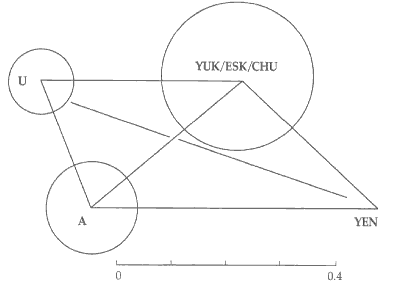 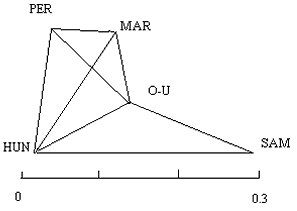 |
HUN - Hungarian language
MAR - Mari language
OU - Ob-Ugric languages
PER - Permic languages
SAM - Nenets languages |
168
We can easily represent any three of these distances graphically (Figure 2), when limited
to two dimensions. (9) We can also join some edges of such triangles, so as to represent
the distances to some further groups. In Figure 2, all distances are rendered exactly,
except the longest, from U to YEN. The latter corresponds to the length of the
interrupted line that does not reach the U and YEN corners. We can mentally raise the YEN
corner out of the plane of the paper, until the distance U-YEN becomes 0.53, as given in
Table 5. Then the four groups would form a tetrahedron where all four distances
correspond exactly to those shown in Table 5 (Which must reflect
some phenomenon outside of the methodological scope, since all parameters represent
single-dimensional scalars and relative distances that conceptually belong to the
two-dimensional Uralic space. Applying this methodology to the Altaic group would create
a distinct two-dimensional Altaic space, which would partially overlap the Uralic space.
Each of the two spaces can be expressed in a two-dimensional self-contained format, but
their combination would need a three-dimensional graph. Moreover, because the development
of each individual language follows an exponential algorithm, in respect to each other
each two-dimensional space would have its own curvature with its own mean exponential
factor. The resultant graph would resemble a three-dimensional graph of pealing apart a
stuck of two sheets of paper, or rather two sheets of dough, since the triangles drawn on
the dough would change their shape to reflect the inherent flexibility approximated in
the model with rigid triangles. The languages intermediate between the two
two-dimensional graphs would separate from their plane, creating floating hills connected
to both bases by a mushroom stem. In a three-dimencional space, the distances will differ
from their projections on the two-dimensional plane depicted in this study. See Note 9).
Hypothethical example of 3D model
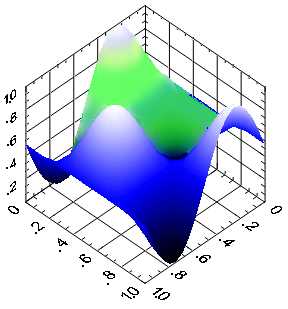
The diameters of the circles shown correspond to the mean distances of subgroups within
the major groupings, as indicated on the diagonal of Table 5. They remind us that
within-group distances are sometimes comparable to those among the groups (especially
regarding YUK/ESK/CHU).
This visual presentation highlights the observation that, compared to YEN and
YUK/ESK/CHU, Uralic and Altaic are relatively close, so that the old notion of a
Uralic-Altaic super-group surfaces. YUK/ESK/CHU is equally distant from U, A, and YEN,
which is far away from the rest.
3.2. Distances among Uralic and Altaic subgroups
It was noted that FIN/SAA/MOR and OU/PER/MAR appear as the closest-knit clusters, with
all intra-cluster distances being less than 0.10. FIN and PER link these two clusters.
Fusing the subgroups within these clusters helps to visualize their mean distances to
other subgroups. We are left with 4 clusters within U. Their average distances among
themselves and to subgroups of Altaic are shown in Table 6. Once again, the subgroups/clusters are presented in such an order as to make the distances increase from left to
right and from the bottom to the top. No "errors" arise, by the criteria stated earlier.
The distances among the clusters within U are visualized in Figure 3. All distances are
exact, except the longest, from HUN to SAM. The latter distance corresponds to the length
of the line that does not reach the HUN and SAM corners. The clusters OU/PER/MAR,
FIN/SAA/MOR and SAM are at essentially equal distances from each other, while HUN stands
apart, being fairly close only to OU and PER in the OU/PER/MAR cluster. In other words,
instead of the conventional division of U into Finno-Ugric and SAM, this set of features
divides U into Finno-Samoyedic and Hungarian.
Figure 3. Distances among four clusters within Uralic.
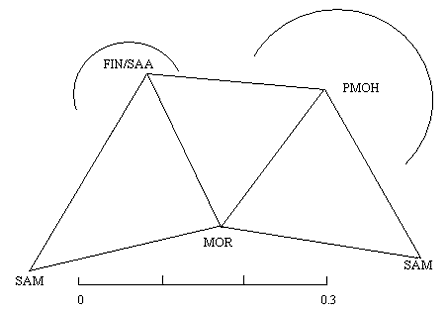 |
3D model
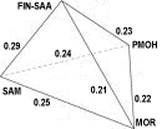 |
FIN/SAA - Finnic-Saami Group
PMOH - Perm-Mari-Ob-Ugric-Hungarian Group
MOR - Mordvin languages
SAM - Nenets languages |
2D model
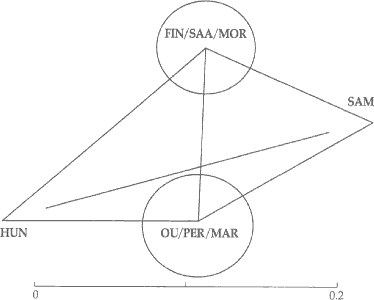 |
169
The "Ugric" commonalities of HUN and OU stand out only when viewed from the Hungarian
vantage point - as was historically the case in Uralistics. From this vantage point,
Ob-Ugric is indeed the closest group, but the reverse it not true. From the OU vantage
point, not only MAR and PER but also SAM offer more commonalities than HUN. Moreover, the
other three subgroups (FIN, SAA, MOR) are not much further than HUN.
Within this pattern of groups within groups, MOR and SAM offer a cross-cutting
disturbance. MOR is close to FIN and SAA, yet also has features that make it close to SAM
(0.10). Moreover, more than any other U or A subgroup, both MOR and SAM have also
features in common with ESK (distance 0.26) and CHU (0.30 and 0.27, respectively). We'll
return to this issue. (10)
Figure 4. Distances of Altaic and Uralic subgroups
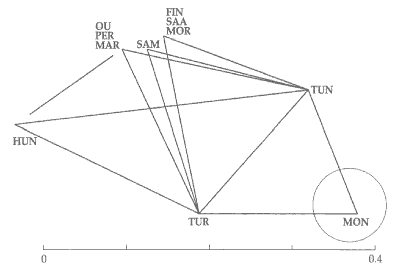 |
FIN/SAA - Finnic-Saami Group
HUN - Hungarian language
MAR - Mari language
MON - Mongolic languages
MOR - Mordvin languagesOU - Ob-Ugric languages
OU - Ob-Ugric
PER - Permic languages
PMOH - Perm-Mari-Ob-Ugric-Hungarian Group
SAM - Nenets languages
TUN - Tungusic (or Tungus-Manchu) languages
TUR - Turkic languages |
Figure 4 shows the distances among the three subgroups of A. It also shows the distances
of clusters within U to TUR and TUN. If distance lines were drawn from clusters within U
to MON, they would all end within the dotted circle shown. The distance from HUN to
OU/PER/MAR corresponds to the length of the line that does not reach the OU/PER/MAR and
HUN corners.
Within A, MON and TUN appear closer to each other (0.15) than HUN is to most U
subgroups. TUR appears equidistant from MON and TUN. In their distance to Uralic
subgroups, TUR and TUN are pretty much on a par, except for HUN, which is very distant
from TUN while also exceptionally far from TUR. From the vantage point of TUR, all U
subgroups but HUN are almost as close (0.20 to 0.21) as TUN and MON (0.19). Within the
U-A super-group, the TUR-TUN axis looks central, with MON on the one side and the U
subgroups on the other - and not much more distant, except for HUN.
(The relative position of the Türkic TUR, Mongolic MON and
Tungusic TUN languages is consistent with the hypothesis that Mongolic and Tungusic
emerged from the same continuum of languages in contact, and the Mongolic brunched off
under an influence of the Türkic continuum of languages. The Tungusic also experienced
the influence of the Türkic languages, with the influence distinct from the
Türkic-Mongolic influence. The influences are mutual, but not symmetrical for both
directions)
The remoteness of HUN and TUR (0.34) is notable in view of age-old claims of a tie
between them, competently reviewed by A. Marcantonio (2002). In our analysis, however,
what distinguishes HUN from the other Uralic subgroups is not Turkic or other Altaic
affinities - to the contrary, Hungarian appears as the Uralic subgroup the most distant
from Turkic (and other Altaic).
We should consider a possible artifact. The previous example of Estonian and Finnish
reminds us that a subgroup with many languages and dialects is more likely to harbor a
given feature in some of its corners, especially when history has split these languages
or dialects politically, thus increasing their isolation. In contrast, a subgroup
consisting of a single language is less likely to offer such variety, especially if this
is a state language with a long literary tradition that has absorbed the dialects. This
is of course the case for HUN. Only 31 of the features considered occur in HUN, which
does reduce the potential for commonalities with other languages
(Apparently, this development impacts not only the closely related vernaculars, but
even very different vernaculars, since it is historically known that HUN for millenia was
a patchwork of a base Hungarian and a multitude of Türkic languages, of which the Hunnic, Avar,
Bulgar, Esegel, Bagjanak and Kipchak were just few examples, and a multitude of IE
languages, of which the Germanic and Slavic are just a few examples).
Standard Estonian, which exhibits 30 features, would be in a comparable situation, if it
were considered a separate subgroup. As a test, the distances of standard Estonian to the
subgroups of U and A were calculated. The mean distance of Estonian to the subgroups of U
apart from HUN is 0.16 - the same as for HUN. Thus the single-language factor may be among
the causes of the apparent isolation of HUN. However, the distances of Estonian to TUR
(0.18), TUN (0.23) and MON (0.33) are much shorter than is the case for HUN (0.25, 0.36
and 0.45, respectively - cf. Table 6). Thus the single-language factor cannot be the sole
cause for the isolation of HUN. HUN does occupy a special position. In some ways, it may
indeed be the "least Altaic" among the U languages.
The Samoyedic-Tungusic commonalities pointed out by A. Marcantonio (2002) turn out to be
few. Compared to other subgroups of U (except HUN), SAM does not emerge as meaningfully
closer to TUN, geographical contiguities notwithstanding. FIN/SAA/MOR, the Uralic cluster
geographically furthest from TUN, has as many commonalities.
It should be recalled that relatively few of the 46 features in the database occur in any
Altaic language group - the number ranges from 32 in Tungusic to only 27 in Mongolic. In
contrast, the count for Uralic languages ranges from 41 to 31 features. It may well be
that Altaicists could complement the present list with numerous features common to Altaic
subgroups and possibly absent in the Uralic languages, changing the picture in Figure 4
appreciably. We hope to induce them to do so.
170
3.3. Distances within and around Paleo-Siberian
We do not consider PS a language group (like U or A) but designate by this term a
residual category of languages that belong to neither U or A. Previous Table 4 showed
that MOR and SAM have more commonalities with some PS languages than any other subgroup
of U or A. Following up on this observation, Table 7 inserts the average distance of
MOR/SAM among the PS languages is such a way as to minimize "error" as previously
defined. Indeed, only one such error occurs (shown as a thick line) when MOR/SAM is
inserted between CHU and YEN. The tightest cluster in this Table is not YUK/ESK/CHU but
ESK/CHU/MOR/SAM. If no other Uralic languages existed, we would happily classify MOR and
SAM as belonging to PS. In this limited sense the "Uralo-Eskimo" hypothesis (Seefloth
2000) receives support.
Figure 5 highlights this relationship. ESK-CHU-YUK and ESK-CHU-MOR/SAM form similar
almost equilateral triangles. The distance between YUK and MOR/SAM is actually much
larger than it appears in the flat scheme. It is as if the MOR/SAM corner were lifted out
of the plane of the page. On the other hand, the distance between YUK and YEN is shorter,
as indicated by the length of the line that does not reach the corners.
171
4. Conclusions
What are the major results, and how adequate are the methods and data used to obtain
them? We will first discuss the general method, followed by results and their validity in
view of the data set used.
The distance measure used is anchored at values 0, 1/2, and 1 in a logical way, and the
simplest measure satisfying these conditions was adopted. No obvious dissonances have
been observed that would suggest adoption of a more complex expression. Two-dimensional
visualization limits us to the use of a concatenation of triangles, and there is some
leeway in the order in which languages (or groups) are chosen to form such triangles.
Some inter-group distances are not shown in the figures and, despite the lack of a
joining line, the visual impression may distort the distance. The only way to avoid such
risks fully would be to multiply the number of graphs or resort to representations using
more dimensions than two. We believe we have avoided wrong impressions.
As for the Uralic grouping, we observe that it does exist, A. Marcantonio's (2002)
well-founded doubts notwithstanding. Practically all intra-Uralic distances are shorter
than those to any languages outside Uralic. A. Marcantonio's reminder about Uralic-Altaic
ties is well taken. Turkic, in particular, has almost as many commonalities with most
Uralic subgroups as with Tungusic and Mongolic. The major surprise, however, is that
Hungarian emerges as the Uralic language the most remote from Turkic and from Altaic in
general, instead of being the closest. The commonalities between Samoyedic and Tungusic,
as pointed out by A. Marcantonio (2002), hardly exceed the Uralic average.
Within Uralic, the cluster of Finnic, Saamic and Mordvin is confirmed (despite the
latter's curious Paleo-Siberian ties). In the geographic center of the Uralic area, Mari,
Permic and Ob-Ugric are found to form another tight cluster. Most surprising, Hungarian
rather than Samoyedic emerges as the most distant from all other Uralic languages
(Most logical explanation is that typical Uralic morphological
features were replaced by functionally identical features from another linguistic group,
with Türkic, Slavic, and Germanic serving as most likely donors. That would explain not
only the distance between Hungarian and other Uralics, but also the apparent distance
between Hungarian and Türkic, which is misleading since it uses the 46 criteria selected
specifically for the Uralic morphology as the features occuring in at least one of the 8
Uralic language groups. This selection retained all the traits particular for the Uralic
group, and excluded all the traits particular for the Türkic group except for the
sampling of 30 traits common for both groups. The inclusion of the excepted traits would
right the balance, linking Hungarian morphologically closer to the Türkic group. It was
noted by a number of researchers that liunguistic classification of the Hungarian was
done more along the political lines then the linguistic reality).
The traditional subdivisions of Uralic have been subject to revision for some time
already - and not surprisingly so. A language can slowly replace most of its vocabulary
while preserving most of its grammar. Thus various lexical and structural considerations
can lead to quite different ways to cut the Uralic pie. Table 8 shows some proposals for
cuts into subgroups and sub-subgroups. Like the traditional view, T.-R. Viitso (2000)
assumes a gradual branching off from a proto-language and implicitly places SAM apart.
Within the rest, he allows for two possibilities:
I. MOR/MAR grouped with FIN/SAA, or
II.
MOR/MAR grouped with PER/HUN/OU.
Compared to traditional, PER is grouped with HUN/OU in
both variants. J. Pusztay (1994) leaves the question of proto-language more open. He sees
only a western and an eastern subgroup, and pushes Mordvin to the east.
172
Our analysis yields four roughly equidistant clusters and takes no stand on how they came
about. But these are not the traditional four groups, to which T.-R. Viitso's groupings
(2000) are close. Along with J. Pusztay (1994), we note a Finnic-Permic connection but
keep Mordvin tied to Finnic-Saamic, despite its Paleo-Siberian commonalities. Our
analysis is the only one to set Hungarian apart from the rest. Yes, Ob-Ugric remains the
subgroup closest to Hungarian, but the reverse is not the case: Ob-Ugric appears even
closer to Mari and Permic. Instead of dividing Uralic into the traditional Finno-Ugric
and Samoyedic branches, our results divide it into Finno-Samoyedic and Hungarian.
The set of features underlying our analysis is extensive and discriminating as far as
Uralic is concerned. The 46 features considered were chosen such that every feature
occurs in at least one of the 8 Uralic language groups considered. They include 25 that
occur in all 8 Uralic language groups. Thus the resulting groupings are based on a fair
number of features, and the outcome could not have been predicted ahead of time through
biased selection of inputs. The four clusters within Uralic that emerge from our study
deserve serious consideration, along with the other formats shown in Table 8.
Regarding Altaic, our most surprising finding is that Turkic appears almost as close to most Uralic subgroups as to Tungusic and Mongolic. The choice of features might be
adequate, given that 37 features occur in at least one Altaic language and 21 occur in
all of them. But probably further features common to Altaic and absent in Uralic
subgroups could be found, thus reducing the distances within Altaic
(Within the limits of the 21 parameter the Uralic and Altaic groups remain two-dimensional; outside of that limit the graphs become three-dimensional, and any cluster that has shared parameters between
Uralic and Altaic groups is located between two-dimensional surfaces of each group in a
three-dimensional space; outside of the shared parameters, the behavior of each group is
completely independent of each other. Since the same approach is applicable to each set
of languages treated as a group, complementing the review with features common to
Tungusic and Mongolic and respactively absent in Altaic, Uralic, and Paleo-Siberian,
would produce a three-dimensional graph for the whole Northern Eurasia. See Note 9).
As for Paleo-Siberian non-group, 34 of the features considered occur in at least one
language but only 6 occur in all of them. Yeniseian stands apart, but the other three are
also as remote from each other as Uralic is from Altaic. There are hints of a deep layer
common to Uralic-Altaic and the Paleo-Siberian languages. There are also hints of
reciprocal borrowings among the Paleo-Siberian languages and two Uralic
languages - Samoyedic and, most puzzling, Mordvin.
The broad picture is one of definite commonalities between Uralic and Altaic, and more
distance from them to the hazy Paleo-Siberian grouping. All these findings are tentative
and subject to cross-checking through other approaches. At the same time the method used
looks of sufficient promise to recommend that analogous sets of structural features be
collected for the languages around the Mediterranean to establish a comparable set of
features so as to compare Semitic, Hamitic, Indo-European and Basque languages. Extension
to Dravidian, Korean, Japanese and Ainu would also be of interest.
173
APPENDIX: Database
The 46 structural features considered
P. Klesment, A. Kunnap, S.-E. Soosaar and R. Taagepera (2003) considered the occurrence
of 60 features in U, A, PS, and also IE. We exclude from our analysis the Indo-European
languages and 14 of the features, for the following reasons.
The database focuses on features that occur in northern Eurasia and does not include the
numerous features common to Indo-European languages. Until one adds such features, one
cannot draw any conclusions on the distances within IE or its distances to U, A and PS.
Once Indo-European is omitted, 14 of the features occur in only 1 or 2 of the 15
subgroups considered. (All others occur in at least 4.) The 10 "Finnic-Baltic" features
connect FIN (and sometimes SAA) to Baltic and Slavic (and sometimes Germanic), while
being completely absent in other Indo-European subgroups as well as in any other U, A or
PS subgroup. By increasing the total count (ai) for FIN, they artifactually increase the
distances
[d.sub.ij] = 1 - [a.sub.ij]/[([a.sub.i][a.sub.j]).sup.0.5]
from FIN to all
other U groups. Similarly, the 4 "Samoyedic" features, which spill over to only one PS or
A subgroup, artifactually increase the distances from SAM to all other subgroups.
Therefore, we omit these 14 features, leaving a total of 46 (For a
group comparison, removal of unique innovations or borrowings peculiar to a single member
is a methodological necessity to clear the signal of the noise).
These 46 features are listed below, indicating their occurrence in the subgroups of U, A,
and PS, as well as in Germanic [GER], Slavic [SLA], Baltic [BAL]. The labels of groups of
features are those in Klesment et al. (2003). IE indicates occurrence in Indo-European
languages other than G-S-B = GER-SLA-BAL. For the same data in the form of a matrix for
each feature in each language, see Klesment, Kunnap, Soosaar, Taagepera 2003, which also
lists the source materials for each feature.
174
(Section omitted)
175Strengths and weaknesses of the set of features
The overriding value of this set of structural features supplied by P. Klesment, A.
Kunnap, S.-E. Soosaar and R. Taagepera (2003) is that it has been collected at all and
made available, even while their quality may vary. The choice of features was made by
Uralists, and it shows: All 46 features do occur in at least one Uralic language. Thus
the extent of occurrences of these features in a given language is in some ways a measure
of its "Uralicity". Outside the conventional Uralic group, where the number of
occurrences ranges from 31 (HUN) to 41 (MOR and SAM), the most "Uralic" would seem to be
TUN (33), TUR (30) and ESK (28). Further structural features should be collected,
including those that occur in Uralic languages rarely or not at all, so as to obtain a
more balanced picture of the language groups in northern Eurasia. This would need input
from specialists on Basque, IndoEuropean, Altaic, Paleo-Siberian, Ainu and even
Dravidian.
The "occurrence" of a feature in a language or group does not necessarily indicate
extensive occurrence. It may not be typical of the groups involved and thus may overstate
group proximity. On the other hand, it may still indicate that these groups have a
predisposition for the rise of such a rare feature
(Introduction of a weight parameter allows to account for small abberations, potentially
reducing the impact of noise distortons. In color applications, the weightless
reconstruction leads to greying of the picture, potentially totally obscuring details and
blending separate images).
176
REFERENCES
Aikhenvald, A. Y. 2003, Mechanisms of Change in Areal Diffusion. New Morphology and
Language Contact. - Journal of Linguistics 39, 1-29.
Biber, D. 1986, Spoken and Written Textual Dimensions in English. - Language 62, 384-414.
Dixon, R. M. W. 1999, The Rise and Fall of Languages, Cambridge.
Embleton, S. M. 1986,
Statistics in Historical Linguistics, Bochum.
Fortescue, M. 1998, Language Relations across Bering Strait. Reappraising the
Archaeological and Linguistic Evidence, London - New York.
Georg, S., Vovin, A. 2003, From Mass Comparison to Mess Comparison. Greenberg's
Indo-European and Its Closest Relatives. - Diachronica 20, 331-362.
Greenberg, J. 2000, Indo-European and Its Closest Relatives. The Eurasiatic Language
Family I. Grammar, Stanford.
Haspelmath, M. 1998, How Young is Standard Average European? - Language Sciences 20,
271-287.
Klesment, P., Kunnap, A., Soosaar, S.-E., Taagepera, R. 2003, Common Phonetic and
Grammatical Features of Uralic Languages and Other Languages in Northern
Eurasia. - Journal of Indo-European Studies 31, 363-390.
Kunnap, A. 2000, Contact-Induced Perspectives in Uralic Linguistics, [Munchen - Newcastle]
(LINCOM Studies in Asian Linguistics 39).
Marcantonio, A. 2002, The Uralic Language Family. Facts, Myths and Statistics,
Oxford - Boston (Publications of the Philological Society 39).
McMahon, A., McMahon, R. 2003, Finding Families. Quantitative Methods in Language
Classification. - Transactions of the Philological Society 101, 7-55.
Nichols, J. 1992, Linguistic Diversity in Space and Time, Chicago - London.
Ostman, J.-O., Raukko, J. 1995, The 'Pragmareal' Challenge to Language Tree Models. - The
Fenno-Baltic Cultural Area, Helsinki, 31-69.
Pusztay, J. 1994, A Linguistic Model of Determining the Original Home of the Uralic
Nations. - Finno-ugrovedenie 1 [|ookar-Ola], 23-40.
Pusztay, J. 1995, Diskussionsbeitrage zur Grundsprachenforschung (Beispiel: das Protouralische),
Wiesbaden (Veroffentlichungen des Societas Uralo-Altaica 43).
Renfrew, C. 2000, At the Edge of Knowability. Towards a Prehistory of
Languages - Cambridge Archeological Journal 101, 7-34.
Ringe, D. 1999, How Hard Is It to Match CVC-Roots? - Transactions of the Philological
Society 97, 213-244.
Ringe, D., Warnow, T., Taylor, A. 2002, Indo-European and Computational
Cladistics. - Transactions of the Philological Society 100, 59-129.
Seefloth, U. 2000, Die Entstehung polypersonaler Paradigmen im
Uralo-Sibirischen. - Zentralasiatische Studien 30, 163-191.
Taagepera, R. 1994, The Linguistic Distances between Uralic Languages. - LU XXX, 161-167.
Taagepera, R. 2000, Uralic as a lingua franca with Roots. - FU 23, 381-395.
Thomason, S. G., Kaufman, T. 1988, Language Contact, Creolization, and Genetic
Linguistics, Berkeley.
Viitso, T.-R. 2000, Finnic Affinity. - CIFU IX. Pars I, 153-178. Wiik, K. 2002,
Eurooppalaisten juuret, Jyvaskyla.
177
Notes
(1) Given that people tend to live a good part of a century and that young people and old
people may speak somewhat differently, a reasonable operational dividing line between
synchronic and diachronic approaches might be to count as synchronic those features that
have been used during the last 100 years.
(2) The present-oriented criterion differentiates this database from the set of 72
morphological features used by J. Greenberg (2000) for his "Eurasiatic" macrogroup.
(3) In which way are single similar phonemes more significant in morphosyntactic features
than in lexical ones? Compared to a single phoneme functional ending, a multi-phoneme
word root has a higher probability that one of the phonemes happens to be the same by
random coincidence. This possibility is enhanced when reconstructions allow for
correspondences between quite distinct phonemes. In contrast Klesment. Kunnap, Soosaar,
Taagepera 2003 allows for only minor variants such as u/w (Feature 17 in Appendix), i/j
(Features 21 and 24), and at most, m/b (Feature 32). But of course, the quality of
features used here also varies.
(4) The limitations of linguistic expertise excluded other languages such as Korean and
Japanese that S. Georg and A. Vovin (2003) include in a "Macro-Tungusic" or "Manchuric"
group, as well as Ainu and Gilyak. Compared to the Eurasiatic macrogroup proposed by J.
Greenberg (2000), the database excludes Indo-European, Korean, Japanese, Ainu and, of
course, Etruscan, while adding Yeniseian. Compared to earlier Nostratic approaches, the
database also excludes Kartvelian, Dravidian and Afro-Asiatic, while adding
Paleo-Siberian languages. This choice of languages by no means implies denial of any
wider connections. It would be easier to criticize the scope chosen than to propose
another set of comparable extent that would itself be immune to critique. Widening it to
everything from Japanese to "Standard Average European"-Sprachbund (Haspelmath 1998) and
beyond would of course be the eventual goal (see Conclusions) - but first the novel
methodology proposed here should be tested in a more restricted range.
(5) Major differences between our approach and J. Nichols' (1992) include the following.
J. Nichols focuses on the diversity of populations of languages, while we focus on their
distances (in terms of lack of commonalities). J. Nichols considers sample individual
languages (such as 3 out of the many Uralic languages) over a wide range, while we
consider all languages conventionally labeled Uralic, Altaic and Paleo-Siberian, lumping
languages so similar that no controversy about relatedness has arisen. Our analysis
applies a binary YES/NO criterion to the existence or non-existence of a feature in the
given subgroup of languages; J. Nichols has room for more nuanced specifications. As a
technical difference, J. Nichols' booksize study includes the details of features studied
and the sources, while our article refers to Klesment, Kunnap, Soosaar, Taagepera 2003 in
this respect.
(6) It could be well argued that languages with no commonalities are at an infinite
distance from each other. This is easily done - just use
[d'.sub.ij] = [d.sub.ij]/(1 - [d.sub.ij]) = ([a.sub.i][a.sub.j])0.5/[a.sub.ij] - 1.
Finite distances, however, are
handier for visual representation.
(7) There are ways to define distance so as to avoid such a paradox, but they introduce
further inconsistencies. A more general formula to tie a measure of distance to
[c.sub.ij] = [a.sub.ij][([a.sub.i][a.sub.j]).sup.0.5]
is
[d".sub.ij] = [[1 -
[a.sub.ij.sup.m]1/n].
All such measures have a range from 0 to 1. Our measure [d.sub.ij]
corresponds to m = 1, n = 1. If we set m = 2 and n = 1, we always can construct a
triangle for three languages. However, languages that have one-half the features in
common now appear at a distance not 0.5 but 0.707 units from each other - awkwardly close
to the utter maximum distance of 1. Such an outcome blurs the distinction between
relatively close and extremely distant languages. No combination of m and n can satisfy
at once both of these conditions (half-commonality at 0.5 and ability to always construct
a triangle). A table of Northern Eurasian distances calculated with m = 2, n = 1 is given
in Klesment, Kunnap, Soosaar, Taagepera 2003.
(8) How robust are these results against adding or subtracting features? Suppose we add
the use of polysyllabic words, which is common to all languages considered but would
distinguish them from Chinese. The impact would be the strongest in the case of languages
with the fewest features noted, YEN and YUK. Features occurring in YUK would increase
from 21 to 22, and those in YEN from 15 to 16. Their present overlap of 11 would become
12. As a result, [d.sub.ij] would shrink from 0.38 to 0.36. The change would be even less
extensive for all other language pairs. Thus the distances are fairly robust against
minor changes in the choice of features.
(9) To represent fully the distances between N groups, it would in general take an (N - 1) dimensional space. Thus, even the use of 3-dimensional models would not allow us to go
much further (Computation sould not be confused with
illustration; the (N - 1)-dimensional space is a mathematical model without
visualising qualities; a 3-dimensional illustration nesessarily distorts the absolute
linear values, in accordance with conventions adopted for the 3D model, to achieve
visualisation).
(10) On grounds of current or recent geographical locations, some PS commonalities with
SAM and even OU might be expected, but MOR is more puzzling. MOR does not stand out by
its links to Altaic, yet has more commonalities with PS than does any other language
presently spoken west of the Urals. Along with strong linkages to Finnic-Saamic in the
west, Mordvin also contains a persistent eastern strain, as previously noted by J.
Pusztay (1994), who joins Mordvin to Ugric and Samoyedic, to form the eastern trunk of
Uralic (Inclusion of Altaic morphological features would bring
more consistency in the model, based on 1.5 millennia of historical connections between
the MOR and TUR people. The present Mordva is identified with the Late Antique/Middle Age Burtases,
where second syllable cals them Ases, and even if that was a politonym, their assocoation
with the Ases of the Classical authors, Ptolemaic Amadoci and Borusci, and Middle Age Burtases
and Murtases retains the ethnonym Ases in all its forms. A branch of Ases is mentioned in
the Orkhon inscriptions, vaguelly locating them in the headwaters of Biya and Enisei, ca
51°N 88°E. Consideration of the historical dynamics would reduce the degree of
puzzlement, and help to direct attention to the possible explanations).
(11) HUN features a compound verb that joins the roots 'vagy' and 'len-' that leads to an expression not quite equivalent to 'to be at', although such exclusion may be debatable.
(12) Occurrence of 'to be at' need not exclude a more formal 'to possess'. Most languages
of the world lack a verb for 'have', but in the light of its occurrence in most
contemporary IE languages (and in YUK, CHU and ESK), its absence is worth noting.
(13) Use of postpositions does not perforce imply absence of prepositions.
(14) In some Finno-Ugric languages -k > -j or vowel and in some Samoyedic languages -k >
glottal stop (Here we may have slipped into diachronic reconstruction).
REIN
TAAGEPERA (Tartu - Irvine, California), AGO KUNNAP (Tartu)
178
(Appendix tables omitted)
181

